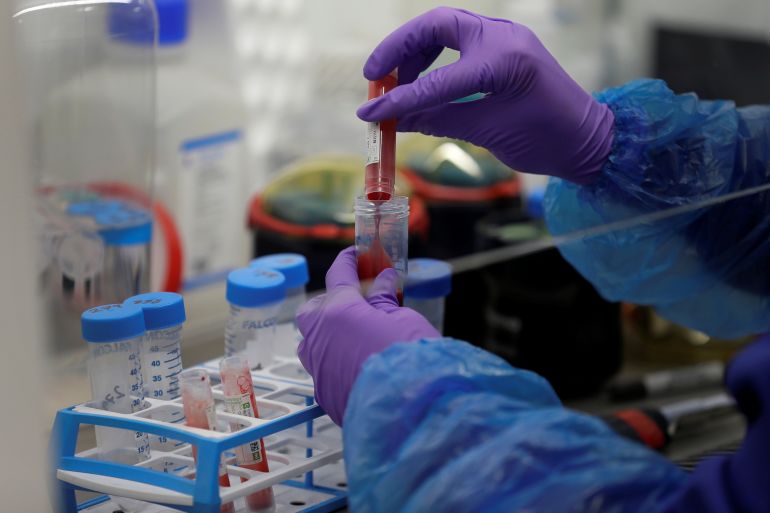What is the ‘zombie deer disease’ that experts warn may spread to humans?
A case of the chronic wasting disease in Yellowstone National Park has raised concerns of spread to humans.

In what scientists call a “slow-moving disaster”, a “zombie deer disease” is spreading across the United States after a case was detected in Yellowstone National Park.
The lethal disease has no cure and is prevalent in deer and elk, but studies suggest that it may spread to humans.
Keep reading
list of 3 itemsSky-high inflation takes a toll on mental health in Argentina
50,000 women pregnant in Gaza amid ‘decimation’ of its health system
Here’s what we know about the disease and whether people should be worried.
What is zombie deer disease?
Zombie deer is a chronic wasting disease (CWD) that first surfaces in deer, elk, reindeer, sika deer and moose, according to the Centers for Disease Control and Prevention (CDC), a national health agency in the US. It is unclear how the name “zombie deer” emerged.
It eats away at the brains of those animals and causes dementia-like symptoms, eventually leading to death. There are also no treatments or vaccines.
CWDs are spread by prions – a set of proteins that are almost indestructible and affect both animals and humans. They cause a type of rare progressive neurodegenerative disorder – which means it affects the nervous system and gradually worsens.
The World Health Organization has urged keeping agents of known prion diseases, such as animals infected with zombie deer disease, from entering the human food chain. However, there is no strong evidence that humans can get infected with CWD prions from animals.
What are the symptoms of zombie deer disease?
The prions of the disease cause cells in the brain and spinal cord to fold abnormally and start clumping.
Around a year after getting infected, animals start showing symptoms including dementia, wobbliness, drooling, aggression and weight loss.
Where has zombie deer disease been detected?
A deer carcass in Yellowstone National Park tested positive for the disease in mid-November, announced the National Park Service.
The CDC also reported that “as of November 2023, CWD in free-ranging deer, elk and/or moose has been reported in at least 31 states in the continental United States, as well as three provinces in Canada”.
Cases have also been reported in Norway, Finland, Sweden and South Korea.
The first-ever zombie deer disease case, however, was first discovered in Colorado in 1967, according to the US Geological Survey.
Chronic Wasting Disease has been confirmed in a Yellowstone National Park mule deer found near Yellowstone Lake.
To avoid bringing CWD home with us, we’re all going to have to take extra steps in the field to be part of the solution. To learn more, visit https://t.co/iHGnrGPmFn pic.twitter.com/5MGtElizlk
— The TRCP (@TheTRCP) November 20, 2023
What is the risk of zombie deer diseases spreading to humans?
So far, there have not been any reports of zombie deer disease transmitting to humans.
Experimental research on CWDs suggests, however, that it is a possibility, especially if humans eat infected meat. Currently, the CDC estimates that up to 15,000 animals infected with CWD are eaten each year.
Additionally, the temperatures needed to cook off its prions in meat are far above regular cooking temperatures.
Within animals, it spreads through their saliva, urine, blood or faeces. The prions can also remain in environments for a long time, according to the CDC.
Have diseases spread from animals to humans before?
It’s fairly common. In the 1980s and 90s, “mad cow” disease was found to have spread from animals to humans in the United Kingdom. A total of 232 people worldwide have died from the disease, according to the Food and Drug Administration based in the US.
From rabies to avian influenza, zoonotic diseases — that can spread from animals to humans — have long posed a major public health challenge that has been exacerbated as humans have encroached more and more into the natural habitats of a range of animal species.
COVID-19, the world’s most devastating pandemic in a century, is also widely believed to have spread to humans from animals in a wet market in the Chinese city of Wuhan. Nearly 7 million people around the world have died from COVID-19 in less than four years.
What precautions can people take against zombie deer disease?
The CDC has listed several precautions against eating meat infected with CWDs, such as:
- Test hunted animals before eating the meat.
- Avoid “deer and elk that look sick or are acting strangely or are found dead”.
- Use latex or rubber gloves when removing the internal organs of hunted deer, while minimising contact with the brain and spinal cord tissue.
- Do not use household knives or kitchen utensils when handling deer meat.
Determining whether a deer is infected can only take place after it is killed because testing requires samples of tissue deep within the brain.